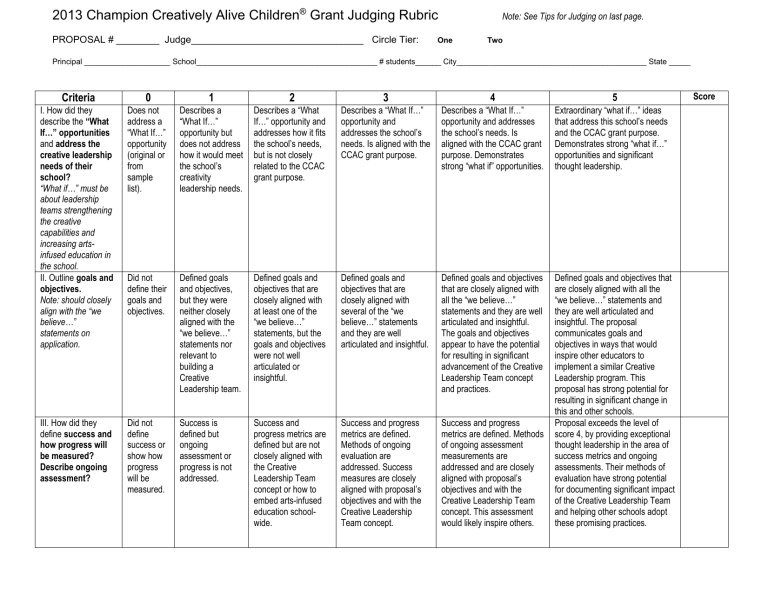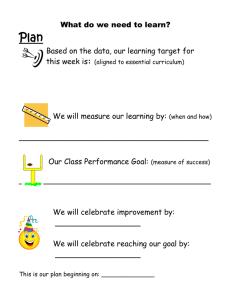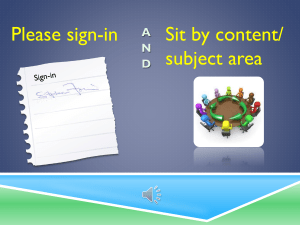scoring rubric

2013 Champion Creatively Alive Children
®
Grant Judging Rubric Note: See Tips for Judging on last page.
PROPOSAL # ________ Judge________________________________ Circle Tier: One Two
Principal ____________________ School__________________________________________ # students______ City____________________________________________ State _____
Criteria
I. How did they describe the “What
If…” opportunities and address the creative leadership needs of their school?
“What if…” must be about leadership teams strengthening the creative capabilities and increasing artsinfused education in the school.
II. Outline goals and objectives.
Note: should closely align with the “we believe…” statements on application.
III. How did they define success and how progress will be measured?
Describe ongoing assessment?
0
Does not address a
“What If…” opportunity
(original or from sample list).
Did not define their goals and objectives.
Did not define success or show how progress will be measured.
1
Describes a
“What If…” opportunity but does not address how it would meet the school’s creativity leadership needs.
Defined goals and objectives, but they were neither closely aligned with the
“we believe…” statements nor relevant to building a
Creative
Leadership team.
Success is defined but ongoing assessment or progress is not addressed.
2
Describes a “What
If…” opportunity and addresses how it fits the school’s needs, but is not closely related to the CCAC grant purpose.
Defined goals and objectives that are closely aligned with at least one of the
“we believe…” statements, but the goals and objectives were not well articulated or insightful.
Success and progress metrics are defined but are not closely aligned with the Creative
Leadership Team concept or how to embed arts-infused education schoolwide.
3
Describes a “What If…” opportunity and addresses the school’s needs. Is aligned with the
CCAC grant purpose.
Defined goals and objectives that are closely aligned with several of the “we believe…” statements and they are well articulated and insightful.
Success and progress metrics are defined.
Methods of ongoing evaluation are addressed. Success measures are closely aligned with proposal’s objectives and with the
Creative Leadership
Team concept.
4
Describes a “What If…” opportunity and addresses the school’s needs. Is aligned with the CCAC grant purpose. Demonstrates strong “what if” opportunities.
Defined goals and objectives that are closely aligned with all the “we believe…” statements and they are well articulated and insightful.
The goals and objectives appear to have the potential for resulting in significant advancement of the Creative
Leadership Team concept and practices.
Success and progress metrics are defined. Methods of ongoing assessment measurements are addressed and are closely aligned with proposal’s objectives and with the
Creative Leadership Team concept. This assessment would likely inspire others.
5
Extraordinary “what if…” ideas that address this school’s needs and the CCAC grant purpose.
Demonstrates strong “what if…” opportunities and significant thought leadership.
Defined goals and objectives that are closely aligned with all the
“we believe…” statements and they are well articulated and insightful. The proposal communicates goals and objectives in ways that would inspire other educators to implement a similar Creative
Leadership program. This proposal has strong potential for resulting in significant change in this and other schools.
Proposal exceeds the level of score 4, by providing exceptional thought leadership in the area of success metrics and ongoing assessments. Their methods of evaluation have strong potential for documenting significant impact of the Creative Leadership Team and helping other schools adopt these promising practices.
Score
2013 Champion Creatively Alive Children
®
Grant Judging Rubric Note: See Tips for Judging on last page.
PROPOSAL # ________ Judge________________________________ Circle Tier: One Two
Principal ____________________ School__________________________________________ # students______ City____________________________________________ State _____
Criteria
IV. How will they identify and share
Creative Leadership
promising practices with other schools?
V. Why/how is proposal innovative?
0
Did not address how promising practices would be identified.
Proposal does not address innovation.
1
Promising practices are discussed but are either unclear or not closely aligned with
Creative
Leadership
Team’s purpose or do not address how they will be shared.
Application says it is innovative but the proposed idea is already in common practice in many schools.
2
Promising practices are discussed and they are aligned with the Creative
Leadership Team’s purpose, but plans do not address sharing them with other schools.
Application points out what is innovative about this idea.
Proposed idea is commonly talked about and is seen in some schools, but this is a new/novel way of implementing the idea.
3
Promising practices are discussed and align with
Creative Leadership
Team’s purpose. Plans address sharing with others, but are not likely to have significant impact on other schools.
Application points out what is innovative about this idea. While the proposed idea is commonly discussed in education, it is not yet in common practice in schools.
4
This proposal would likely create new promising practices that are well articulated and aligned with the Creative Leadership
Team’s purpose, and have strong potential for influencing other schools.
Application points out what is innovative about this idea.
The innovation is currently not common practice in schools and the ideas are truly innovative for schools. It is likely that other schools could implement this plan.
5
This proposal is stellar in articulating how they will create and identify new promising practices that are aligned with the
Creative Leadership Team’s purpose. They will likely have a significant impact on other schools and generate new promising practices that Crayola and NAESP can showcase.
This exceptional proposal is highly innovative—the idea is new/novel and has potential to generate innovative solutions and improved learning outcomes here and in other schools. The proposal explains why this is innovative and how these cutting edge ideas can help shape educational practices beyond their school. Implementation in other schools is very likely.
Score
VI. What
collaboration is planned?
Note: Preference is given to applications that emphasize school-wide, parental, and/or community involvement.
Application does not describe collaboration
Application describes minimal collaboration (not beyond the team who authored the proposal).
Application describes collaboration that is broad-based, includes members of the teaching staff, plus others, including classroom teachers, literacy specialists, administrators and/or parents.
Application describes collaboration that is broad-based, includes members of the entire teaching staff including specialists as well as district administrators, parents, and some
“unexpected members” beyond the school
(community members, museum partners, arts organizations, university partners, etc.)
Application describes collaboration similar to score
3, but this collaborative model is articulated in ways that would inspire others to implement and the model could be easily transferred to other schools.
This exceptional application describes a collaboration plan beyond score 4. The proposal is well articulated and provides thought leadership on community collaboration. The outcomes of this project would likely generate new collaboration models that
Crayola and NAESP can showcase, demonstrating what educators, parents and partners in the community can do together to champion creatively alive children.
2013 Champion Creatively Alive Children
®
Grant Judging Rubric Note: See Tips for Judging on last page.
PROPOSAL # ________ Judge________________________________ Circle Tier: One Two
Principal ____________________ School__________________________________________ # students______ City____________________________________________ State _____
Criteria
VII. How sustainable
is the program?
Have they addressed the ability to implement aspects of this program beyond the CCAC grant funding period?
Preference given to
“long term” plans
versus “an event”.
VIII. Provide Key
Contacts. Outline
timeline (with key milestones) and show work plan
(spanning October
2013 to May 2014)
0
Application does not describe sustainability of either the program or ideas.
Application contains contacts, but unclear on roles.
Vague timeline or work plan.
1
Application does describe sustainability of some aspects of the program or non-consumable supplies purchased, but does not seem to embed new promising practices in the school’s future plans.
Application includes key contacts but their roles are unclear.
Application contains a rough timeline that spans full year, but not a detailed work plan.
2
Application describes what aspects of the program or idea will continue beyond initial funding, but will be limited unless the school finds new resources to continue the project.
Application includes key contacts but some roles seem to be missing or do not seem to significantly involve school leaders. Application contains timeline with milestones. Work plan includes key milestones but no detailed work plan.
3
Application describes what aspects of the program or idea will continue beyond initial funding and become embedded in school culture.
Application includes key contacts, states their roles, and all responsibilities outlined in the proposal are assigned to someone.
Key leaders are involved in the project. Contains detailed timeline, work plan contains key milestones and gives the judge confidence that the plan will be implemented.
4
Application describes what aspects of the program or idea will continue beyond initial funding, become embedded in school culture, and provide a model for other schools or community organizations to follow.
Application includes key contacts and roles. Key leaders are involved in the project. Contains detailed timeline with key milestones and the work plan gives the judge confidence that the plan will be implemented.
This plan appears to be a model that could be applicable to other schools.
5
Application goes beyond what is required for score 4. The ideas in this proposal will have significant long-term impact on the school, and will influence educational practices beyond initial funding.
The sustainability model proposed increases the likelihood of implementation at other schools.
The application is outstanding.
Contains all information for score
4 and went beyond. School leaders are very involved in this project. Work plan is a clear model that other schools could implement and is an ideal example of how a Creative
Leadership Team can impact a school. The results of this work plan will likely result in examples that can be showcased and implemented elsewhere.
Score
IX. Outline Budget
(include how funds would be used). List other resources or
contributions applied to the program. N ote: While some technology might be needed, proposals that indicate the majority of funds would be spent on technology are less likely to be funded. Projects that beautify school are not
Budget included is vague and lacks important information about planned expenditures.
Budget is clear on how $2,500 would be spent, but there is not enough emphasis on building a
Creative
Leadership Team or there is overemphasis on purchase of technology which applicants were urged not to
Budget is included and is clear on how
$2,500 would be spent. But only some of the planned expenditures are closely aligned with the Creative
Leadership Team purpose or only a weak plan to spread school-wide.
Budget is included. Clear on how $2,500 would be spent. All the expenditures are closely aligned with the “we believe…” statements and Creative Leadership
Team purpose. This proposal would fund a program that would advance creative capacity school-wide.
Budget included is clear on how $2,500 would be spent and addresses what other resources will be leveraged to build creative capacity in the school. Expenditures are closely aligned with “we believe… “ statements and
Creative Leadership Team purpose. This proposal would fund a program that would significantly
advance creativity in this school and likely be a model
Budget is clear on how $2,500 would be spent and addresses what other resources will be leveraged to build creative capacity in the school.
Expenditures are very closely aligned with “we believe…” statements and Creative
Leadership Team purpose. This proposal would fund a program that would significantly advance creative leadership in this school.
This model could be applied to other schools and will very likely
2013 Champion Creatively Alive Children
®
Grant Judging Rubric Note: See Tips for Judging on last page.
PROPOSAL # ________ Judge________________________________ Circle Tier: One Two
Principal ____________________ School__________________________________________ # students______ City____________________________________________ State _____
Criteria likely to be funded.
Projects that impact a full school and build creative capacity of the school-wide learning community will be more likely to be funded that those that focus on a handful of participants or beneficiaries.
0 1 propose or the funds are too narrowly focused on the benefit of a few people without a plan for how they will build creative capacity schoolwide.
2 3 4 adopted by other schools.
5 inspire other schools to implement a similar program, even if those schools don’t receive a grant.
Score
TOTAL SCORE:
Tips for Judging: The information below can help clarify some of the terminology in the judging rubric.
“What if…” opportunity: While the RFP contained some sample “what if…” questions, we urged applicants to use those only as a springboard and to come up with their own ideas, not just use those. The application stated, “What if School Creative Leadership Teams…
…wove arts-infused education across the curriculum and throughout the school?
…served as Chief Creative Officers, responsible for increasing the creative capabilities and confidence of students and teachers?
…helped parents and educators value and nurture children’s original thought?
…developed comprehensive project-based authentic assessments that value children’s creativity?
Submissions are not limited to the “what if…” ideas above. We encourage a “what if…” that addresses the school’s needs.”
Goals and Objectives: The proposal should be aligned with the Crayola—NAESP Core Beliefs: “At Crayola and NAESP we believe…
in the power of children’s original thought.
arts-infused education engages students and results in robust, memorable learning.
children are empowered by creative leaders.
it takes a visionary leadership team to enhance a school’s creative collaborative culture.
“what if…?” is a great question that makes leaders explore new possibilities and implement change”.
Art-infused education (sometimes called Art Integrated Education) is a cross-curricular way of teaching about and with the arts, to build knowledge and competency in various subjects including art, reading, math, science and social studies.
Use a score 5 to note a proposal that is EXTRAORDINARY. Submit comments along with total score to explain why the proposal stands out and what makes it exceptional beyond the categories on the rubric.






